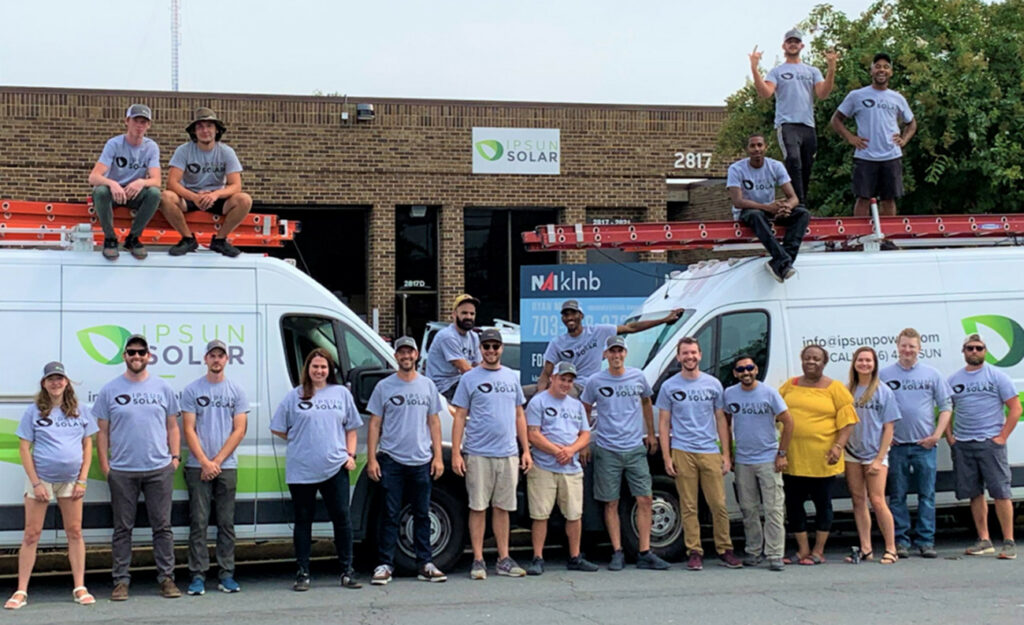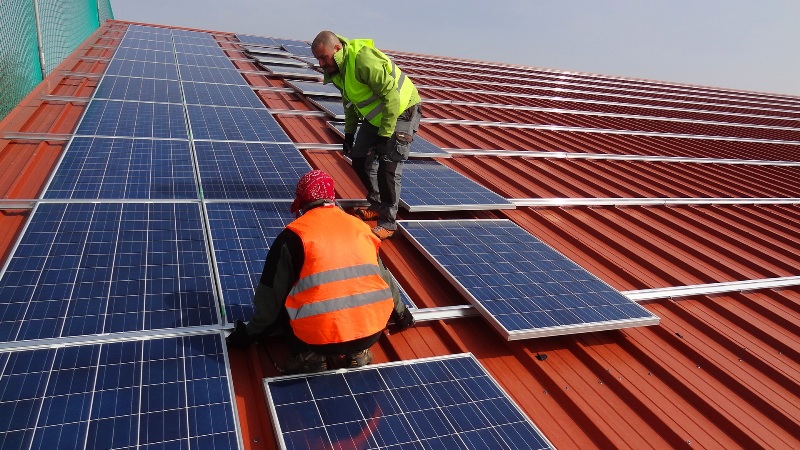Not all solar projects are created (or installed) equal, so let’s start by highlighting the key differences between commercial and residential solar projects.
1. Fit and Aesthetics
Although commercial solar arrays are typically designed and sized in a similar manner as residential systems, commercial solar clients prefer systems that blend into and enhance their business surroundings and ideally portray their commitment to social responsibility. For example, this commercial project designed by Tres Birds Workshop and installed by AAE Solar (see below) shows a solar installation on the wall of a mixed-use building.
Given that commercial installations typically involve a much larger array than the average residential rooftop installation, commercial projects will require more effort and planning due to the sheer size. Also, the fact that two commercial sites are rarely identical when compared to a typical residential rooftop.
2. Placement
The go-to method of installation for residential is typically on the roof. However, in commercial arrays, a ground mount system may be the better option for a couple of key reasons. See below, for an example from Alternative Energy Systems.
First, the sheer size and weight of the panels make for a bulky installation so designing a ground-mount will potentially mitigate any risk to the roof (depending on age and condition) and save the client any additional alterations to the roof.
Second, if the roof is flat, it will require ballast bays which can weigh up to a ton and will potentially require permits and inspections, potentially delaying the project. Therefore, unless there is a shortage of land at the commercial site, a ground mount can be the better option.
3. Modules
In terms of the solar module itself, efficiency is key. Highly efficient modules will ensure that the commercial array works to its maximum potential. With the rise in high efficiency and wattage modules, the options for the commercial arrays are vast. Using high watt modules decreases the number of solar modules needed for the project but saves cost in modules and shipping as well.
A lesser number of modules will also decrease the number of racking pieces you will need and save costs as well. It is not uncommon for solar manufacturers to produce highly efficient modules above 300 watts in today’s market.
A commercial inverter is also a necessity for any commercial project. Some projects may benefit from the use of microinverters, however, keep in mind that microinverters typically add to project cost. As an advantage, microinverters are known to have a warranty that is double that of a string inverter. Efficiencies between modules and microinverters must be calculated to see if the energy output will maintain or better the projected ROI.
4. Sales and Marketing
There is no point in discussing best practices in commercial solar installations if you don’t have any clients to start with. A lot of our clients deal with both commercial and residential projects, and, yes, there are differences in how you market and sell to each segment. One of the most crucial differences is a longer sales cycle with commercial as there are more decision makers involved and the projects tend to be more complex, so expect to have a healthy backlog of leads that take time to nurture and come to fruition. As mentioned earlier, commercial projects also involve different hardware, more permits and safety regulations, and different levels of warranties and maintenance as part of the cost.
5. Project Management Tools
Once you are up and running with best practices on the sales and marketing side, you need the right tools to manage your commercial solar projects successfully. Pre-sales checklists, Site Survey forms, PV installation procedures, O&M and Preventative Maintenance Checklists are just a few of the key components required to successfully (and efficiently) complete and operate any solar project.
Some of the features that you need to look for include in optimizing your field ops tasks are:
- Mobile-friendly apps which replace paper forms and checklists
- The ability for your team to connect instantaneously anywhere, whether it’s for just-in-time remote troubleshooting or to share the latest updates
- Centralizing your data in one place (including forms, pics, video, messages, manuals, forms)
- PDF reporting and dashboards
- Custom mobile apps which can be customized to suit your user workflows
Next Steps
- New to Scoop? Contact us to schedule a free consultation and demo
- Visit the Scoop Solar website for general information on how Scoop is helping empower today’s new liquid workforce.


